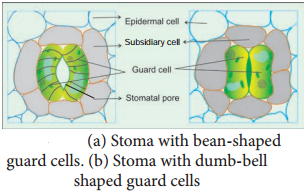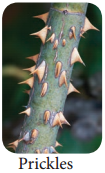Learninsta presents the core concepts of Biology with high-quality research papers and topical review articles.
Epidermal Tissue System Definition and its Types
Introduction
Epidermal Tissue System
Is the outer most covering of plants. It is in direct contact with external environment. It consists of epidermis derived from protoderm. Epidermis is derived from two Greek words, namely ‘Epi’ and ‘Derma’. ‘Epi’ means upon and ‘Derma’ means skin.
It is made up of single layer of parenchyma cells which are arranged compactly without intercellular spaces. Although epidermis is a continuous outer layer, it is interrupted by
stomata in many plants.
Leaf Epidermis
The leaf is generally dorsiventral. It has upper and lower epidermis. The epidermis is usually made up of a single layer of cells that are closely packed. Generally the cuticle on the upper epidermis is thicker than that of lower epidermis. The minute openings found on the epidermis are called stomata (singular: stoma).
A stoma is surrounded by a pair of specialised epidermal cells called guard cells. In most dicots and monocots the guard cells are bean-shaped. While in grasses and sedges, the guard cells are dumbbell- shaped. The guard cells contain chloroplasts, whereas the other epidermal cells normally do not have them.

Subsidiary Cells
Stomata are minute pores surrounded by two guard cells. The stomata occur mainly in the epidermis of leaves. In some plants addition to guard cells, specialised epidermal cells are present which are distinct from other epidermal cells.
They are called Subsidiary cells. Based on the number and arrangement of subsidiary cells around the guard cells, the various types of stomata are recognised. The guard cells and subsidiary cells help in opening and closing of stomata during gaseous exchange and transpiration.
Epidermal Outgrowths
There are many types of epidermal outgrowths in stems. The unicellular or multicellular appendages that originate from the epidermal cells are called trichomes. Trichomes may be branched or unbranched and are one or more one celled thick. They assume many shapes and sizes. They may also be glandular (Example: Rose, Ocimum) or non-glandular.
Piliferous layer of the root has two types of epidermal cells, long cells and short cells. The short cells are called trichoblasts. Trichoblasts are elongate into root hairs. Epidermal hairs can also be in the form of stellate hairs (star shaped) present in plants. Example: styrax, many members of Malvaceae and Solanaceae.

Prickles
Prickles, are one type of epidermal emergences with no vascular supply. They are stiff and sharp in appearance. (Example: Rose).

Functions of Epidermal Tissue System
- This system in the shoot checks excessive loss of water due to the presence of cuticle.
- Epidermis protects the underlying tissues.
- Stomata is involved in transpiration and gaseous exchange.
- Trichomes are also helpful in the dispersal of seeds and fruits, and provide protection against animals.
- Prickles also provide protection against animals and they also check excessive transpiration.
- In some rose plants they also help in climbing.
- Glandular hairs repel herbivorous animals.